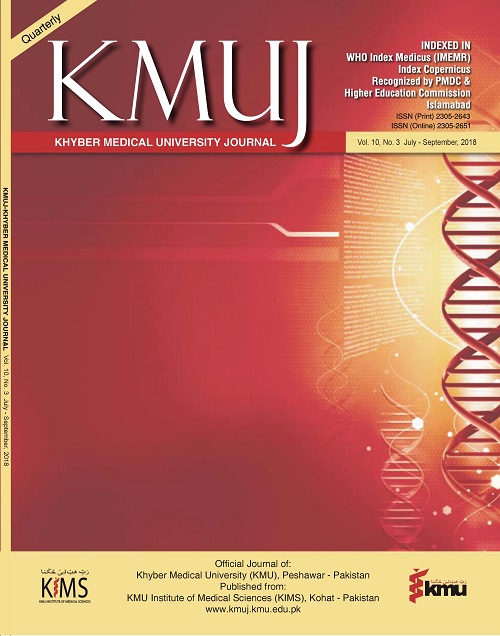INTRAMUSCULAR DELTOID INJECTION ABSCESS IN PATIENTS PRESENTED TO A TERTIARY CARE HOSPITAL IN KHYBER PAKHTUNKHWA
Main Article Content
Abstract
ABSTRACT
OBJECTIVES: To find out the reasons of deltoid injection abscess in female patients and disseminate awareness in our population.
METHODS: This descriptive cross-sectional study was conducted in the female Outpatient Department of surgery at Khyber Teaching Hospital, Peshawar, Pakistan from April 2017 to December 2017. All female patients with age more than 14 years who presented with deltoid injection abscesses on either arm were included and patients with diabetes, bleeding disorders, major debilitating disorders or immune-compromised conditions were excluded. All patients were interviewed regarding the Intramuscular injection technique and data was collected on a structured proforma and analyzed on SPSS 20.
RESULTS: A total of fifty female patients were studied in which 56% were in the age group of 26-45years with mean age 35.5±12.93 years, 14 (28%) qualified and 36 (72%) non-qualified personnel administered the injection. It was injected over the sleeve in 41 (82%) patients while in only 9 (18%) patients the arm was exposed properly. The reasons for insignificant exposure came out to be social reasons in 9 (18%), time deficiency in 9 (18%), improper trained personnel in 19 (38%), tight sleeves in 4 (8%) patients. In 9 (18%) patients aseptic measures were used while in 41 (82%) patients no aseptic measures were taken.
CONCLUSION: Mostly patients received intramuscular injection over the sleeves due to simple avoidable reasons from local practitioners due to lack of awareness.
KEY WORDS: Injection abscess (Non-MeSH); Deltoid Muscle (MeSH); Local Practitioner (Non-MeSH).
Article Details
Work published in KMUJ is licensed under a
Creative Commons Attribution 4.0 License
Authors are permitted and encouraged to post their work online (e.g., in institutional repositories or on their website) prior to and during the submission process, as it can lead to productive exchanges, as well as earlier and greater citation of published work.
(e.g., in institutional repositories or on their website) prior to and during the submission process, as it can lead to productive exchanges, as well as earlier and greater citation of published work.
References
REFERENCES
World Health Organization (WHO). Safety of injections: A brief background. WHO, Geneva. Fact Sheet no. 231, 1999.
Lala MK, Lala KR. Review of injection practice. Indian J Practical Pediatr 2001;3:72-5.
Hunter J. Intramuscular injection techniques. Nurs Stand 2008;22(24):35-40.
Waleem SSU, Khan YS, Tarar HM. Major Flaws in Technique of Intramuscular Injections. Pak Armed Forces Med J (PAFMJ) 2013;63(2).
Treadwell T. Diagnostic dilemma: intramuscular injection site injuries masquerading as pressure ulcers. Wounds 2003;15(10):302-12.
Yuan J, Liu Y, Yang Z, Cai Y, Deng Z, Qin P, et al. Mycobacterium abscess. Post injection abscesses from extrinsic contamination of multiple dose bottles of normal saline in a rural clinic. Int J Infect Dis. 2009;13(5):537-42. DOI: 10.1016/j.ijid.2008.11.024
Ebright JR, Pieper B. Soft tissue infections in injection drug users. Infect Dis Clin North Am 2002;16(3):697-712.
Akbar Z, Nizami K, Ahmad F, Alam M. Incidence and aetiology of intramuscular injection abscess. Pak J Med Health Sci 2014;8(3):720-22.
McGarvey M, Hooper AC. The deltoid intramuscular injection site in the adult. Current practice among general practitioners and practice nurses. Ir Med J 2005;98(4):105-7.
Devi DR, Indumathi VA, Indira S, Babu PR, Sridharan D, Belwadi MR.. Injection site abscess due to Mycobacterium fortuitum: a case report. Indian J Med Microbiol 2003;21(2):133-4.
Harsch IA, Pietzcker T, Wiest GH, Hahn EG, Ficker JH. Recurrent gluteal injection abscesses as a complication of frequent intramuscular self-injection. Med Klin 2001;96(5): 298-9.
Beecroft PC, Redick S. Possible complications of intramuscular injections in the pediatric unit. Pediatr Nurs 1989;15(4):333-6.
Wynaden D, Landsborough I, McGowan S, Baigmohamad Z, Finn M, Pennebaker D. Best practice guidelines for the administration of intramuscular injections in the mental health setting. Int J Ment Health Nurs 2006;15: 195-200. DOI: 10.1111/j.1447-0349.2006.0 0423.x
Afridi SP, Memon A, Alam SN. Recurrent abscesses following an intramuscular injection of diclofenac sodium. J Surg Pak 2011;16(2):82-4.
Simonsen L, Kane A, Lloyd J, Zaffran M, Kane M. Unsafe injections in the developing world and transmission of bloodborne pathogens: a review. Bull World Health Organ 1999;77(10):789-800.
